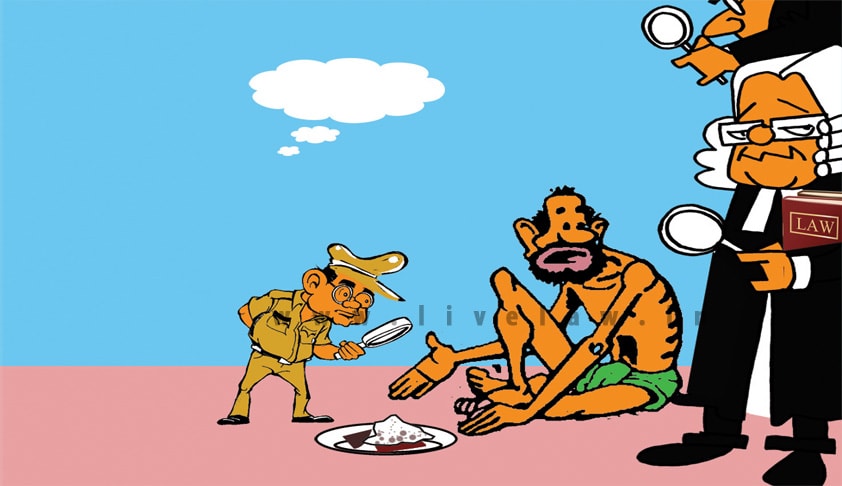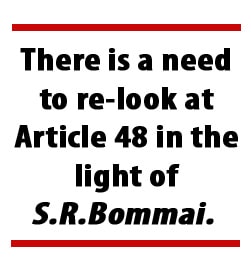Ban on Cow Slaughter: The Camouflage of Article 48
By: Sandhya Ram | October 20, 2015

In primary school, we had a composition book in which we wrote compositions on different topics. One such topic was ‘The Cow’. I neither remember having written anything like “Cow is my mother”, or “The cow is more than a mother to me”, nor did I write about the cow being sacred. I might have written that cow is a domestic animal; that cow gives us milk; that cow has four legs and a tail;or that cow dung is used as manure. Excuse me, I hail from the State of Kerala, where I never came across anything about cow worship, though I adored Krishna and used to admire the pictures in Amarchithrakadha where I saw pictures of the charming Krishna with his beautiful cows. It is true that I had habitually touched with respect the stone Nandi in Shiva temples, but had not given much thought to it, as I had done the same with the stone mouse at the Ganapati temple too.
The topic most debated these days is ‘the cow’. In social media, compositions are being written about ‘The Cow’ once again. When some people consider cow to be sacred and ‘ought’ to be worshiped, others don’t find any such sanctity over a cow, in spite of whether they eat beef or not. It is nothing but a matter of faith to worship anything, or believe in God or follow any particular religion. No one can impose one’s faith on others and no one can stop another from eating what he likes to eat. This is common sense in a civilized world. But there comes the dilemma of legal restrictions. Living under a state, one is legally entitled to do all that is not prohibited by law. So what if law prohibits beef eating? Is such a law reasonable and if so on what account?
Of course I am aware of Article 48 of the Constitution of India, titled “Organisation of agriculture and animal husbandry” which mentions of prohibition of cow slaughter. I took out my Constitution Bare Act and read again: “The State shall endeavour to organise agriculture and animal husbandry on modern and scientific lines and shall, in particular, take steps for preserving and improving breeds, and prohibiting the slaughter of cows and calves and other milch and draught cattle.” If I had not known the judgments of the Honourable Supreme Court in Mohammed Hanif Quareshi v. State of West Bengal (AIR 1958 SC 731) and State of Gujarat v. Mirzapur Moti Kureshi Kassab Jamat(2005) 8 SCC 534, I would have ended up with a wrong interpretation of Article 48 to mean that prohibition of slaughter is only on animals (both cow and its progeny) which are useful, either as milk-giving or as draught (working) ones.
But then in 1958, Quareshi decision had made it clear that a total ban on slaughter of cows and calves (both male and female) is valid. But so far as other such animals in the progeny, such as she-buffaloes, bulls and bullocksare concerned, the ban on slaughter of animals which have ceased to be draught or milchis not in public interest and hence invalid.
Overruling Quareshi in 2005, Mirzapur decision made it explicit that an effective total ban on slaughter of cow and its progeny is valid. The reasons given were agricultural and economic and also on the finding that cow and it progeny never becomes useless, even after the cattle cease to breed, to work, or to give milk. They still continue to give dung for fuel, manure and biogas and, therefore, they cannot be said to be useless.
I wonder if the utility of the cattle dung and urine increased from 1958 (Quareshi) to 2005 when the Mirzapur judgment was delivered. Or is it that the earlier court failed to consider such a known fact? It is equally possible that the later Court over valued the utility factor to buttress the justification on total ban on slaughter. It could even be a camouflage of the religious factor super added to the utility factor. Chief Justice R.C. Lahoti had observed in his judgment that cow and its progeny, i.e., bull, bullocks and calves are worshiped by Hindus on certain auspicious days and that a good number of temples are to be found where the statue of ‘Nandi’ or ‘Bull’ is regularly worshiped. I fail to understand the need for this observation by the Court, when the parties themselves have not argued onany religious grounds or Article 25, unless judicial process was inclined towards the religious sentiments as well.
Going back to the Constituent Assembly Debates is needed to trace why prohibition of cow slaughter finds a place in the Constitution under a misleading title of organization of agriculture and animal husbandry. If the purpose is the one in the title, then why should there be an absolute ban on slaughter of cows, even when they cease to be milch and breeding. There has to be something attached to the cow which makes it protection prone than a buffalo or an ox or a bull, which are milch or draught as well. One finds it difficult to imagine that it could be religious reasons because our Constitution establishes a secular state.
I would have misunderstood that the call for slaughter prohibition in Article 48 is indeed for agriculture and animal husbandry purpose, if not for the Constituent Assembly Debates. Was I not shocked to read the debate of Pandit Thakur Bhargava appealing for ban on cow slaughter by stating that “Our ancient sages and Rishis, realising her (cow) importance, regarded her as very sacred. Here, Lord Krishna was born, who served cows so devotedly that to this day, in affection he is known as “Makhan Chor”.
Was our Constituent Assembly working on religious emotions and passion while framing the greatest document for a secular nation, assuring Liberty of thought, expression, belief, faith and worship to all its citizens?
After reading Bhargava, Seth Govind Das turned out to be a milder surprise when he stated that,“I belong to a family which worships Lord Krishna as “Ishtadev”. I consider myself a religious minded person, and have no respect for those people of the present day society whose attitude towards religion and religious minded people is one of contempt”.
Shri R.V. Dhulekar was eloquent: “It (Justice) means that we shall be protected, our families shall be protected. Andour Hindu society, or our Indian society, has included the cow in our fold. It is just like our mother. In fact it is more than our mother. I can declare from this platform that there are thousands of persons who will not run at a man to kill that man for their mother or wife or children, but they will run at a man if that man does not want to protect the cow or wants to kill her.”
It appears that these members were keen on inclusion of the prohibition of cow slaughter clause in the Fundamental Rights. However Dr. B.R. Ambedkar was instrumental in including the provision in Directive Principles instead of in Fundamental Rights. The inclusion in Fundamental Rights would have made this provision an enforceable fundamental right, whereas its inclusion in the Directive made it a non-justiciable, nevertheless an enabling provision. Thakur Bhargava had indeed been ‘generous’ enough to agree for the inclusion of the provision in the Directive Principles, by stating that “I do not want that due to its (Article 48) inclusion in the Fundamental Rights, non-Hindus should complain that they have been forced to accept a certain thing against their will.”
It is interesting to note that two members belonging to the Muslim community, showed great tolerance to the religious demands of the Hindu members on this matter. Syed Muhammad Sa’adulla cited an injunction to the Muslims in the Holy Quran “”La Ikraba fid Din”, which means there ought to be no compulsion in the name of religion. Therefore he expressed that he does not like to use his veto when his Hindu brethren want to place this matter in the Constitution from a religious point of view. But he stated that the Assembly come out in the open and say directly: “This is part of our religion. The cow should be protected from slaughter and therefore we want its provision either in the Fundamental Rights or in the Directive Principles.”
Mr. Z.H. Lari expressed his strong disapproval to the indirect manner in which the provision found an entry in the Constitution. According to him, the preceding portion of the clause speaking about modern and scientific agriculture and the subsequent portion banning slaughter of cattle do not fit in with each other. He made it clear that he was not opposing the provision per se, but demanded clarity in the matter. He said, “Let that article be there, but for God’s sake, postpone the discussion of the article and bring it in clear, definite and unambiguous terms so that we may know where we stand and thereafter there should be no occasion for any misunderstanding between the two communities on this issue which does not affect religion but which affects practices. Lari preferred that the clause be rather placed with clarity in Fundamental rights than in the ambiguous way in which it was put in the Directive. He submitted that “In the interests of good-will in the country and of cordial relations between the different communities this is the proper occasion when the majority should express itself clearly and definitely.”
The proposal of Bhargava was accepted and Article 48 (draft Article 38 A) was added to the Constitution on 24th November 1948. Attempts made by the Drafting Committee headed by Dr. B.R. Ambedkar to change the words of Article 48 to give it a milder effect was effectively blocked by Thakur Bhargava when the draft Constitution was taken up for approval a year later on 14th November 1949. The Drafting Committee had redrafted the Article as “The State shall endeavour to organise agriculture and animal husbandry on modern and scientific lines and shall in particular, take steps for improving the breeds of milch and draught cattle including cows and calves and for prohibiting their slaughter.” The change made by the Drafting Committee was pointed out to be a substantial alteration of the provision that was agreed to by the House and therefore the original article as proposed by Bhargava was passed and Article 48 was added to the Constitution on 16th November 1949.
On 25th November 1949, a day before the Constitution was adopted by the Assembly, Mr. Frank Anthony expressed his strong views on the matter. He said that he resented the insidious way in which Article 48 had been brought in and stated, “I cannot help saying that those fanatics and extremists who could not bring in this provision through the front door have succeeded in bringing it through the back-door. Sir, I am not a beef eater; I am not holding a brief for beef eaters. I say, you may ban co-slaughter, but we should have done it honestly without our tongues in our cheeks, without resorting to methods which may give rise to the accusation of subterfuge.” This is exactly the criticism today an objective researcher would make on this matter.
I now understand that the intention of the makers in incorporating prohibition of cow slaughter in Article 48 was religious reasons predominantly, though economic reasons were projected as well. But Dr. B. R. Ambedkar saw to it that the clause was placed without any religious language. This might have been a measure of giving in to the majority in the Constituent Assembly which was inevitable on one hand and appeasing the minority on the other. However the apprehension of Mr. Z.H. Lari turned out to be true as we can see from the disputes in and out of court in respect of Article 48 and the growing religious intolerance in the country arising out of beef eating and prohibition of cow slaughter.
It seems there are two kinds of people in this world – those who eat beef and those who don’t. Categorizing people on the basis of their eating habits and determining their corresponding entitlements has a long history tainted with untouchability and social stratification. This is regressive and violative of the constitutional goals of rule of law and liberty.
It is not to be forgotten that secularism is part of basic structure of the Constitution as has been held in S.R.Bommai v. Union of India (AIR 1994 SC 1918). If that be the case, State should not directly or indirectly enter into policy making or legislating on religious grounds whatever it may be. On the ground of ‘never-diminishing utility value of the cow’, Supreme Court had upheld complete ban on cow slaughter. It does take courage to call a spade a spade, and calling it by another name wouldn’t make it any less a spade.
There is a need to re-look at Article 48 in the light of S.R.Bommai. The beef ban and cow slaughter prohibition laws emanating from Article 48 have to be in tune with the purpose of the legislation, which cannot be a religious one per se. Any other objective should stand the test of reasonableness and constitutionality.
emanating from Article 48 have to be in tune with the purpose of the legislation, which cannot be a religious one per se. Any other objective should stand the test of reasonableness and constitutionality.
 emanating from Article 48 have to be in tune with the purpose of the legislation, which cannot be a religious one per se. Any other objective should stand the test of reasonableness and constitutionality.
emanating from Article 48 have to be in tune with the purpose of the legislation, which cannot be a religious one per se. Any other objective should stand the test of reasonableness and constitutionality.
Citizens are to be sternly told by the government that liberty is to each to believe, to worship, to eat or not to eat. Matters of religion, like the personal laws are personal to each religion, which they may choose to abide by or not. But no one can force any of his beliefs on others. I only hope that matters of religion be sorted out in heaven, consequences be faced over there and till then let us be! Laissez faire!!!
Epilogue: Now that I think of my school composition, I feel I should also have noted that I loved watching my grand mother’scow, Karumbi being milked. Sitting on the steps I would curiously watch the calf punching hard on its mother’s udder for milk, and the poor calf being pulled away and tied on a pole, when the milk-man would milk the cow. Achamma* would talk to her Karumbipashu**, as if to a human. But these fond memories never made me think against beef eating. I believe it is an individual choice and it remains so.
*Paternal grandmother
** A colloquial name meaning ‘black cow’
REFERENCE
Constituent Assembly Debates, Volume VII, 24th November 1948
Constituent Assembly Debates, Volume XI, 14th November 1949
Constituent Assembly Debates Volume XI, 16th November 1949
Constituent Assembly Debates, Volume XI, 25th November 1949
Mohammed HanifQuareshi v. State of West Bengal (AIR 1958 SC 731)
S.R.Bommai v. Union of India (AIR 1994 SC 1918)
State of Gujarat v. Mirzapur Moti Kureshi Kassab Jamat (2005) 8 SCC 534
Sandhya Ram is an Asst. Professor at V.M.Salgaoacar College of Law, Goa



No comments:
Post a Comment